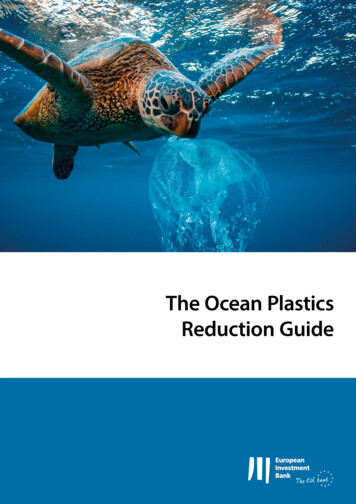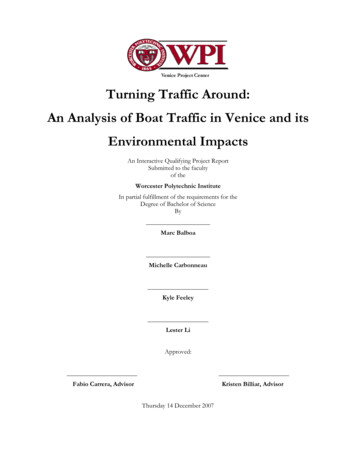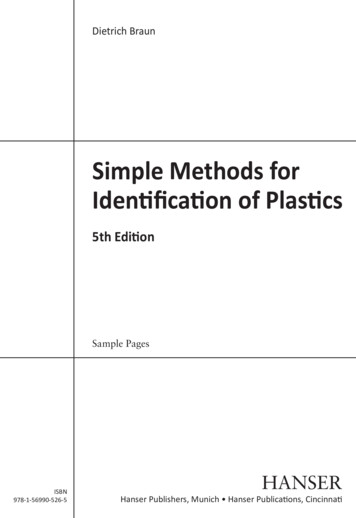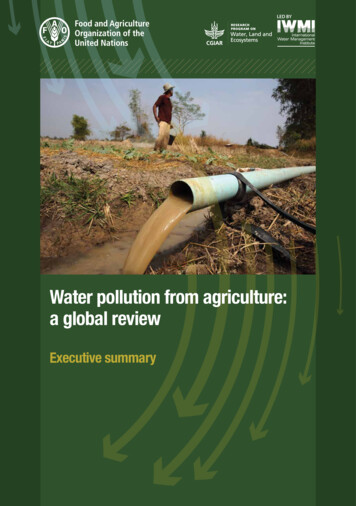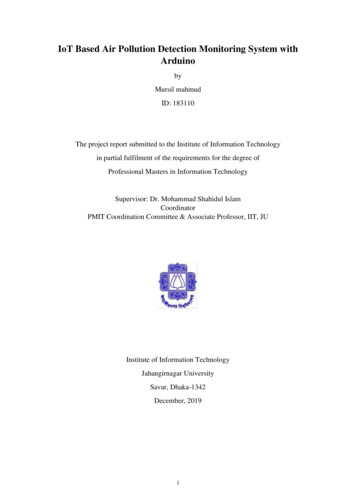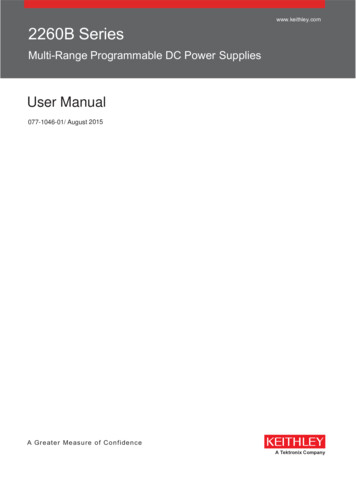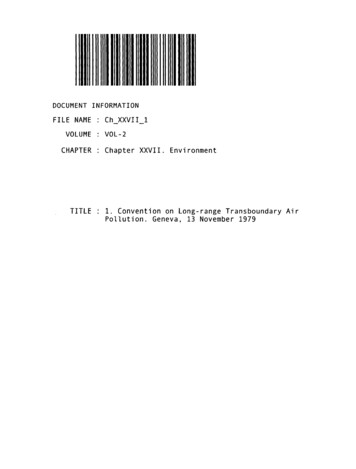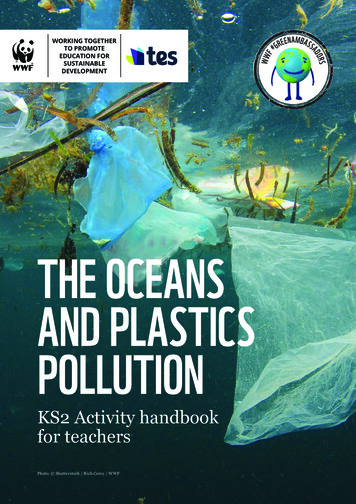
Transcription
WORKING TOGETHERTO PROMOTEEDUCATION FORSUSTAINABLEDEVELOPMENTTHE OCEANSAND PLASTICSPOLLUTIONKS2 Activity handbookfor teachersPhoto: Shutterstock / Rich Carey / WWF
THE OCEANS AND PLASTICS POLLUTIONKS2 ACTIVITY HANDBOOK FOR TEACHERSTHE OCEANS ANDPLASTICS POLLUTIONINTRODUCTIONWherever we live, whether in a large city or close to a sandy beach, we all depend on the oceans.From the frozen ice caps of the polar regions to the warm waters of the tropical coral reefs, fromdeep sea vents to shallow seagrass beds, the oceans contain the greatest diversity of life on Earth.They are home to the largest animal that has ever lived on Earth – the blue whale – and to thetiny krill that it eats.Globally, over 700 million people depend on fishing for their livelihoods on our planet, and fishand seafood are the main source of protein for more than a billion of us. But the oceans providefar more than food. They give us oxygen to breathe and, through their role in the water cycle,water to drink. The oceans also absorb greenhouse gas emissions and additional heat.Yet our seas are under threat. If we carry on as we do now, fish and seafood could be overfished,habitats such as coral reefs will suffer, as will the marine life that depends on them, and therecould be more plastic in the ocean than fish by 2050.This resource enables pupils to explore the role of the oceans in our lives and why healthy oceansare so vital to our future. By looking at the impact of plastics pollution on the oceans, pupils willalso consider what steps we can all take to safeguard these precious waters for generations tocome.HOW TO USE THIS RESOURCEThis resource contains a range of activities aimed at teachers of 7-11 year-olds. It is intended thatthis resource will be used in cross-curricular work and all activities can be linked to the NationalCurricula of England, Northern Ireland, Scotland and Wales. Teachers will find that the materialcan be adapted for use with different ages and abilities.Free CPD education forsustainable development(ESD) coursewww.tes.com/institute/wwf-cpd-course1
THE OCEANS AND PLASTICS POLLUTIONKS2 ACTIVITY HANDBOOK FOR TEACHERSThe six activities engage pupils in active learning methods, encouraging them to work togetherto solve problems, to think creatively, and to see themselves as active participants in theircommunities and the wider world.It is hoped that, as they build their knowledge and understanding, they will become aware ofa ‘bigger picture’ and see how seemingly small actions, such as using a plastic drinking straw,can have far reaching consequences. With a growing awareness of the part that they can play increating a better future for our oceans, pupils will take a step on the journey to becoming globalcitizens and sustainability champions of the future.TAKING A CLOSER LOOK AT THE OCEANThe vast blue ocean covers over 70 per cent of the Earth’s surface. Coastal areas play a huge partin our lives. They are amongst the most densely populated places on Earth. About 70 per cent ofthe world’s population lives within 60kms of the coast.The surface of the sea hides a dazzling variety of species living in its different ecosystems below.Up to 2 million species are found in, on or around delicate coral reefs. These are home for up toa quarter of all marine life and around a quarter of all the ocean’s fish start their lives in coralreefs.But the seas also extend to hidden depths. In the total darkness of the ocean floor are volcanicvents – the first of which wasn’t discovered until 1977.Most of us never venture far beyond the coastal waters, yet the oceans help to sustain life onEarth. Oceans create around half the oxygen we use to breathe. They also regulate our climate,absorbing most of the planet’s excess heat. The seas also absorb vast amounts of carbon dioxidesoaking up around a quarter of the damaging carbon produced by human activities – such as theburning of fossil fuels – helping to protect us against the effects of climate change.But today the oceans are under more pressure than ever before and that’s largely due to humanactivity. Overfishing and irresponsible fishing practices are affecting the delicate balanceof life in the seas. With climate change we are seeing sea levels rise and experiencing moreextreme weather events. As the oceans warm and absorb more carbon dioxide, this has causedacidification in some places, with devastating results such as coral bleaching. Arguably theworld’s most iconic coral reef, The Great Barrier Reef in Australia, has now been hit by four masscoral bleaching events in 1998, 2002, 2016, and 2017.Pollution is poisoning our blue planet. Over 80 per cent of this comes from land-based activitiesas our waste eventually flows into the sea. Fertilisers and pesticides leak into rivers, and eachyear 8 million tonnes of plastic waste is dumped in the ocean, and this amount is set to doubleby 2025. In May 2018, a plastic bag was found more than a kilometre down on the sea bed in theworld’s deepest ocean trench.2
THE OCEANS AND PLASTICS POLLUTIONKS2 ACTIVITY HANDBOOK FOR TEACHERSPhoto: Peter Chadwick / WWF.Ocean plastics can harm marine life. Animals can become entangled in fishing nets and plasticrings. Plastic is also accidentally eaten by many species, including sea turtles, which may mistakeplastic bags for jelly fish.Microplastics are particularly dangerous. These tiny pieces of plastic are less than 5mm in size.They are often found as microbeads, in toothpastes and cosmetics. And when we do our washing,fibres from synthetic clothing can eventually reach the sea. When microplastics are eaten byanimals such as plankton, they enter the food chain and can even reach us.Our oceans contain some of the most important, yet least protected ecosystems in the world.Only a tiny fraction of around 4 per cent are designated as protected – even with this smallpercentage it’s unclear how well managed and monitored they are. When we compare that witharound 17 per cent of the world’s forests that are protected, we can see how much we’re fallingshort. We all share a responsibility to look after our oceans. There are many simple steps that wecan all take to reduce our plastic footprint, from making more sustainable shopping choices, torecycling our waste and thinking about what we put down our drains.For the sake of all our futures, now is the time to act.Plastic is designed to last for a very long time. But it hasn’t been around for very long– only since the early 1900s – although it wasn’t until the 1960s that plastics becamemore widely used. Since then, plastic has changed the way we live. It’s cheap and canbe used for many different purposes, from life-saving medical equipment to takeawaycoffee cups.Today we are surrounded by more plastic than ever before. Plastic production hassurged over the past 50 years, from 15 million tonnes in 1964 to 311 million tonnesin 2014, and is expected to double again over the next 20 years.A huge problem is single-use disposable items. Though used for just a fewminutes, these will still be around in hundreds if not thousands of years.Only around 9 per cent of plastic is recycled – but a huge amount ends up in ouroceans. It’s been reported that in the middle of the Pacific there’s a huge area of plasticrubbish, twice the size of France, kept in place by the swirling currents.It’s a reminder of the threat to sea life and ecosystems that plastic poses.And a wakeup call to act now.3
THE OCEANS AND PLASTICS POLLUTIONKS2 ACTIVITY HANDBOOK FOR TEACHERS iStockphoto.com / WWF-Canada. WWF / Troy Mayne. Richard Stonehouse / WWF-UK.Every one of us can do something to stop plastics pollution. Here are a few ideas that you maylike to share with your pupils:1Avoid plastic where possible, for examplebuy cotton buds made with card instead ofplastic.89 Wear clothes made with natural fibres. ry to avoid glitter, or only use eco-friendlyTglitter in school.2Use a reusable bottle for your drinks.3Say no to plastic bags and drinking straws.4Invest in reusable containers and mugs.5Buy unpackaged food and grow your own.6Stop using wet wipes.12Pick up litter. on’t buy balloons for parties, or releaseDballoons into the sky – decorate with morenatural materials instead!13Never flush plastics down the toilet.71011Talk to friends and family about how muchplastic they use.Don’t use products with microbeads inthem (common ingredients to look out forin the ingredients list are polyethylene andpolypropylene).And remember the five Rs: Rethink – what things do you really need? Refuse plastic where you can – it can help make a point. Reduce the amount of plastic you use. Reuse items whenever you can. Recycle as much as possible.4
THE OCEANS AND PLASTICS POLLUTIONKS2 ACTIVITY HANDBOOK FOR TEACHERSCLASSROOM ACTIVITIESACTIVITY 1:WHY DO THE OCEANS MATTER?This introductory activity draws out the importance of the oceans in all our lives.If you are doing it as part of an oceans topic, you may wish to encourage pupils to create a‘thought space’ where they can write down their reflections as the topic develops. Beforebeginning, ask pupils to write down what they already know about the oceans, and what theywould like to find out. At the end of the topic, pupils can think about what they have learned andhow their feelings and opinions have changed.LEARNING OUTCOMES Pupils will reflect on what role the oceans have in their lives. Pupils will explore the concept of interdependence. Pupils will develop their group work skills.RESOURCES NEEDED A large sheet of paper for each group of four pupils. Coloured pens. One copy of the ‘Why do the oceans matter? fact sheet or poster’ for each group of pupils.Download the fact sheet and poster from www.tes.com/wwf-plastics-oceans.You may also like to display a copy of the poster in your classroom.WHAT TO DO Begin by asking pupils to think about what the ocean means to them and discuss this with apartner. Have they ever visited the sea, and if not, would they like to? What did they do at theseaside? Have they ever travelled across the sea or been on a boat trip? Each pair should then join with another and draw up a shared list on the large sheet of paper.This may include swimming, building sandcastles, going on a boat, exploring rockpools, eatingfish and chips, fishing etc. The ocean provides much more than leisure opportunities. Now ask pupils, in their groups, todiscuss what other roles the oceans may play in their lives. They should write these on theirsheet using a different coloured pen.5
THE OCEANS AND PLASTICS POLLUTIONKS2 ACTIVITY HANDBOOK FOR TEACHERS After allowing time for discussion, give each group a copy of the ‘Why do the oceans matter?’fact sheet which contains additional facts. Ask them to add five new facts to their large sheetof paper in a third colour. They will need to agree on which five facts on the fact sheet theyconsider to be the most important. Come back together as a class and take feedback from each group. Were there any facts thatparticularly surprised pupils? How easy was it to agree on just five facts? Has this activitymade them think differently about our oceans? End the session by reflecting on the fact that every one of us depends on oceans for a healthyplanet. Discuss the idea of interdependence and how all living things are connected in a webof life. If we overfish the seas then they will not be able to give us as much food to eat and otherspecies will suffer too. Ask each pupil to think of one message that they would like to pass on to others about theoceans and to share this with the person sitting next to them.FOLLOW UPAsk pupils to draw a poster calling on people to protect the seas. They could choose to illustrateone of the facts from the fact sheet and think of a catchy slogan to go with it.6
THE OCEANS AND PLASTICS POLLUTIONKS2 ACTIVITY HANDBOOK FOR TEACHERSACTIVITY 2:PICTURING THE SEASThis photo activity is a useful starting point for exploring the topic of oceans and plasticspollution and encourages pupils to take a questioning approach.LEARNING OUTCOMES Pupils will understand how human activities are affecting the oceans. Pupils will use photos to explore their feelings about plastics pollution. Pupils will develop their group work skills.RESOURCES NEEDEDPhoto: Shutterstock / Rich Carey / WWF.Photo: WWF / Greg Armfield.Photo: WWF/Troy Mayne.Photo: Martin Harvey / WWF. A copy of one photo (A4 size) for each group of pupils. Before the session, fix each photo to thecentre of a large piece of paper so that pupils can write around it. Download the photos fromwww.tes.com/wwf-plastics-oceans. Coloured pens.WHAT TO DO Divide the class into groups, giving each one a photo to work on. Pupils should discuss whatthey see in the photo and how it makes them feel. Then write down as many questions as they can on the large sheet of paper around it. After a few minutes ask the groups to feed back to the whole class. Draw up a shared list of questions that pupils would like to explore and group these intodifferent types of questions. Some can probably be answered straight away, while others willneed to be researched. The answer to some may depend on the opinion of the person who isanswering it. After examining the photos, explain to pupils that these photos all relate to plastic pollutionin our oceans. This is an issue that threatens the future of our seas and our planet. We can alldo something about plastic pollution and this will be explored in later activities, particularlyActivity 6.7
THE OCEANS AND PLASTICS POLLUTIONKS2 ACTIVITY HANDBOOK FOR TEACHERSACTIVITY 3:OCEANS AND PLASTICS QUIZThis is an engaging activity to introduce a new topic to a class.LEARNING OUTCOMES Pupils will learn more about the oceans and plastics pollution in an interactive way. Pupils will develop their speaking and listening skills. Pupils will develop their group work skills.RESOURCES NEEDED A copy of the ‘Oceans and plastics quiz sheet’ questions for each pair of pupils. Download quizsheet and answers from www.tes.com/wwf-plastics-oceans.WHAT TO DO Divide your class into pairs, giving each one a copy of the ‘Oceans and plastics quiz sheet’questions. Encourage pupils to discuss the figures in the statements: do they think the figurecould be higher or lower? Once they have had the chance to complete the quiz, go through the answers together. You maywish to add some additional information from the answer sheet or share this with pupils. As a class, consider what pupils have found out. Ask each pair to join another and discuss whether there are any statements that particularlyinterested them. What have they learned through this activity?8
THE OCEANS AND PLASTICS POLLUTIONKS2 ACTIVITY HANDBOOK FOR TEACHERSACTIVITY 4:THE LAST STRAW?Through this activity, pupils use different pieces of information to understand the links betweentheir own use of plastic and ocean pollution.LEARNING OUTCOMES Pupils will understand that their use of plastic has an impact on our oceans. Pupils will gain an awareness of their personal power and what they can do to bring aboutchange. Pupils will develop their group work skills.RESOURCES NEEDED Each group will need a copy of ‘The last straw? scenario’ stuck on an envelope and a set of‘The last straw? statements’, cut up, and put inside each envelope. Download the scenario andstatements from www.tes.com/wwf-plastics-oceans. For reference, also download a copy of the ‘Completed timeline’. A large sheet of paper for each group. Eco-friendly glue – did you know that many glues contain plastic?WHAT TO DO Ask pupils how many of them have used a drinking straw in the last week. Discuss where they used them – at home or when eating out? Why do they think drinkingstraws are used? Do they prefer to drink using a straw? Why? Or why not? Now divide the children into groups and give each an envelope with the scenario on the front. Read this as a class and explain to pupils that they are now going to sort the statements in theenvelope. Together these will answer the scenario question. Ask pupils to go through each statement and sort them into a timeline. Point out that somestatements sit alongside others rather than fitting directly into a timeline. When pupils have had time to agree their timelines, they should glue them onto their sheetof paper. Come back together as a class and discuss pupils’ findings. What is the story that has unfoldedabout Dan’s drinking straw? What steps could have been taken at different points along theway to avoid Dan consuming plastic?9
THE OCEANS AND PLASTICS POLLUTIONKS2 ACTIVITY HANDBOOK FOR TEACHERSPhotos: Greg Armfield. Photospin. Photospin. Ask pupils to think about what they have learned. How do they feel about the issue of plasticpollution now? Activity 6 provides a useful follow up to this activity and contains plenty ofideas for practical steps that can be taken to keep our seas healthy. Finally, ask pupils about whether they now feel differently about using plastic drinking straws?10
THE OCEANS AND PLASTICS POLLUTIONKS2 ACTIVITY HANDBOOK FOR TEACHERSACTIVITY 5:PLASTIC POLLUTION IN GREENSEA COVEThrough this role play activity, pupils will be encouraged to look at a range of differentperspectives on the issue of plastic pollution in the seas.LEARNING OUTCOMES Pupils will develop their speaking and listening skills. Pupils will explore the feelings and emotions of those who take different viewpoints.RESOURCES NEEDED One copy of the ‘Role play cards’, cut up and put in an envelope, for each group of five pupils.Download role play cards from www.tes.com/wwf-plastics-oceans.WHAT TO DO Set the scene for the role play by explaining that pupils are going to create a short sketch basedon a scenario. Explain that the residents of Greensea Cove are finding that their seaside townis getting more and more polluted by plastics in the sea and on the beaches. They have decidedto call a meeting so that different groups can discuss the problem with the local councillor. Give each group a set of the role play cards and allow them to decide who is going to take onwhich role. Give each actor a few minutes to prepare. It’s best to keep this time short as role plays workbest when they are informal and not over-prepared. Pupils should feel free to add furtherinformation and present their own interpretation of their characters. Go around the groups and offer support as they prepare their scenes. Come together and allow each group to perform their role play to the class. Make sure that you allow time for the actors to debrief after the performances. Everyoneshould be given the opportunity to express how they felt. Were they happy with the outcome?FOLLOW UPPupils could write a newspaper report about the council meeting, based on one of the roleplays. They should decide on a broadsheet or tabloid style and should include a headline to grabattention, some quotes and photos with captions.11
THE OCEANS AND PLASTICS POLLUTIONKS2 ACTIVITY HANDBOOK FOR TEACHERSPhoto: Shutterstock.OTHER DRAMA ACTIVITIESHot seatingPut one of the role play characters in the ‘hot seat’ and give pupils the opportunity to ask themquestions about their views and actions. This activity can help pupils to develop empathy for aparticular character or viewpoint, especially one which they would not normally share.Conscience alleyGet pupils to make two lines facing each other with a pathway up the middle. A pupil takes onthe part of one of the role play characters and everyone in the class thinks of one thing that theywould like to say to this character. The character then walks between the two lines with pupils,in role, making their statements as they walk past.With younger children, it can be helpful to do this more than once so that less confident pupilshave the chance to think of something to say. At the end, ask the pupils who have walked throughthe conscience alley to say how they felt, and which arguments they found convincing.12
THE OCEANS AND PLASTICS POLLUTIONKS2 ACTIVITY HANDBOOK FOR TEACHERSACTIVITY 6:TURNING THE TIDE ON PLASTICThis activity allows pupils to think about the use of plastic in their everyday lives and the stepsthat they can take to protect the oceans. It is important that pupils do not feel overwhelmed bythe challenge of plastic pollution and so they will explore how each one of them can take action tokeep our seas healthy.You might like to share with your pupils this example of young people having the power to makechange. After witnessing plastic pollution first-hand, Belize schoolgirl Madison Pearl Edwardstook action to encourage others to save our oceans. Her story is a reminder that we need tosupport pupils to tackle difficult environmental issues. Read it at www.tes.com/belize.LEARNING OUTCOMES Pupils will build an understanding of how plastic pollution affects the oceans. Pupils will consider a range of steps that can be taken to reduce the use of plastic. Pupils will develop their group work skills.RESOURCES NEEDED A copy of ‘My plastic diary worksheet’ – one for each pupil. Download the plastic diaryworksheet from www.tes.com/wwf-plastics-oceans. Also download a print out of the ‘What can be done? diagram’ to share with pupils as anexample. A single-use plastic bottle. Some examples of other single-use plastics, for example drinking straws, food and drinkcontainers or wrappers and plastic bags. A large sheet of paper and pens for each group. Smaller sheets of paper and coloured pens.PREPARATIONIn the week before carrying out this activity, ask pupils to keep a ‘plastic diary’, recording howmuch single-use plastic they use. This could be done as a piece of homework. Explain to pupilsthat tonnes of plastic goes into making items that we use once for just a few minutes. Thesesingle-use plastics can last for hundreds of years. Use the items mentioned above to show pupilssome examples of the most common single-use plastics.13
THE OCEANS AND PLASTICS POLLUTIONKS2 ACTIVITY HANDBOOK FOR TEACHERSWHAT TO DO Divide pupils into groups and ask them to consider the role that plastic plays in their lives. They should refer to their ‘plastic diary’ and compare how much single-use plastic they usedover a week. What other plastic items did they use? Perhaps they went to a party where therewere balloons? Or they used products that contain more ‘hidden’ plastics such as wet wipesor synthetic clothing. Hold up a plastic bottle and ask pupils to discuss with a partner how long they think thiswill take to break down in the sea. Are pupils surprised to learn that it could take hundredsof years? What impact might this have on the animals and plants that live in the oceans?And how might this affect us? Discuss how every one of us has a part to play in protecting our oceans from plastics pollution. In their groups, ask pupils to think of ways that we could all use less plastic. Ask them to drawthree circles on their sheet of paper, as shown in the ‘What can be done? diagram’, and writedown as many ideas as possible for what can be done at each level. For example, as individualspupils can say no to plastic drinking straws. At a community level, schools or local communitycentres can invest in reusable food and drinks containers. And at a wider world level,businesses can reduce their plastic packaging. Ask pupils to think about what steps they can take to encourage others to reduce plasticpollution. For example, they could talk to friends and family about saying no to single-useplastics or they could write to businesses asking them to reduce their packaging. Finally, ask each pupil to draw around their hand and, on each finger, write down one thingthat they will do to use less plastic and help keep our oceans free of plastic pollution. Then askthem to agree with a friend one step that they will take over the coming week. You will find alist of suggestions for reducing plastic pollution on page 4. Use these hands to create a ‘hands up for change’ display, telling the rest of the school whatthey can do to cut back on plastics.FOLLOW UPPupils could carry out a school plasticaudit. They could present their findingsto the school council. You will find usefulinformation to support this activity in theWWF Green Ambassador mbassadors.14
THE OCEANS AND PLASTICS POLLUTIONKS2 ACTIVITY HANDBOOK FOR TEACHERSPhoto: Creative Commons, Rey Perezoso.How long does a plastic bottle last?Different kinds of plastic degrade at different times, but it can even take hundredsof years for some items, perhaps longer. According to a report by The Guardian,in the UK we use 38.5m plastic bottles every day and only just over half of theseare recycled.15
THE OCEANS AND PLASTICS POLLUTIONKS2 ACTIVITY HANDBOOK FOR TEACHERSGLOSSARYBIODEGRADABLESomething that can be decomposed by bacteria or other living organisms. For example, a leafmay be broken down by bacteria or fungi. Most plastic is not biodegradable.CLIMATE CHANGEA term which refers to the changing of the Earth’s climate over a period of time, includingwarming and cooling. It is now used to refer to the more rapid warming of the climate whichmost scientists agree is the result of human activities. The burning of fossil fuels, whichinterferes with the natural balance of gases in the atmosphere, is largely to blame. As a result,global temperatures are rising, and we are seeing many effects of climate change including risingsea levels and extreme weather events.ECOSYSTEMA community of all the living things (such as plants and animals) and non-living things (such asair, water, sunlight and soil) which exist in a particular environment.FOOD CHAINA group of living things that are linked by the food that they eat. Plants are usually at the bottomof a food chain. They get their energy/food from the sun. Animals get energy by eating plants orother animals. The animals at the top of a food chain are called apex predators.FOSSIL FUELSFuels such as coal, oil and natural gas that are formed from the remains of plants and animalsthat lived millions of years ago. Fossil fuels are buried deep in the Earth’s crust. When they areburned to produce energy they release carbon dioxide into the atmosphere, which adds to the‘greenhouse effect’.GREENHOUSE GASESGases in the atmosphere, such as carbon dioxide, methane and nitrous oxide, that trap andretain some of the sun’s heat inside the Earth’s atmosphere (the ‘greenhouse effect’). We needto cut man-made greenhouse gas emissions to prevent this greenhouse effect inside the Earth’satmosphere, as the trapped heat is making the Earth warm faster than could happen naturally.HABITATThe natural home or environment of an animal, plant or other organism. A habitat can provideliving things with food, water and shelter. Habitats can be very large (such as a coral reef) orsmall (for example, a rock pool or a log).MICROBEADTiny pieces of plastic that are less than 1 millimetre in size. Some can be seen by the naked eye,but others are much smaller. They can sometimes be found in cosmetics or toothpaste.16
THE OCEANS AND PLASTICS POLLUTIONKS2 ACTIVITY HANDBOOK FOR TEACHERSAfter being eaten by minute organisms such as zooplankton, microplastics can pass up the food chain, from smaller fish to bigger fish, and eventuallyto us. Photo: Krill Photospin.MICROPLASTICSTiny pieces of plastic that are less than 5 millimetres across. Microplastics include broken-downplastic waste, synthetic fibres and microbeads. They are a major cause of ocean pollution.PHYTOPLANKTONTiny microscopic organisms that live in the sea.RENEWABLE ENERGYEnergy that comes from sources that can be replaced or restocked. These include wind, wave,solar, tidal and geothermal power. Fossil fuels are not renewable.SINGLE-USE PLASTICSPlastic products that are only used once before they are thrown away, for example drinkingstraws.ZOOPLANKTONTiny animals, that are often microscopic, that live in the sea. This huge group of animals includessome crustaceans, krill, and the eggs and larvae from bigger animals.17
THE OCEANS AND PLASTICS POLLUTIONKS2 ACTIVITY HANDBOOK FOR TEACHERSABOUT WWFWWF is the world’s leading independent conservation organisation. We’re creating solutions tothe most important environmental challenges facing the planet so people and nature can thrive.This involves working with businesses, communities and governments in over 100 countries.Together, we’re working to safeguard the natural world, tackling climate change and enablingpeople to use natural resources sustainably.www.wwf.org.ukThis stunning short film celebrates the beauty, fragility and resilience of the natural world – andthe people whose lives depend on it. It’s a snapshot – or more accurately hundreds of snapshots –that shows the breadth of WWF’s work across the world.Watch the film at vimeo.com/20873820WWF’s work with schools and young peopleInspiring the next generationWe’ve only got one planet – and it’s beautiful! It’s also necessary for our very survival.For over 30 years, WWF has been working with schools and educators to inspire and supportyoung people to build their knowledge and understanding, develop their skills, and explore theirvalues so they’re motivated and equipped to both enjoy and care for our amazing planet.Through education for sustainable development, we can motivate and empower young people tocome up with creative solutions to the environmental and sustainability challenges we face, andmake positive change happen.To help support both you and your pupils, WWF has developed free classroom resources to helpput sustainability at the heart of your school.www.wwf.org.uk/schools18
THE OCEANS AND PLASTICS POLLUTIONKS2 ACTIVITY HANDBOOK FOR TEACHERSFREE CPD EDUCATION FOR SUSTAINABLEDEVELOPMENT (ESD) COURSEEmpowering young people to make a difference!Tes has partnered with WWF to
1 THE OCEANS AND PLASTICS POLLUTION KS2 ACTIVITY HANDBOOK FOR TEACHERS INTRODUCTION Wherever we live, whether in a large cit

